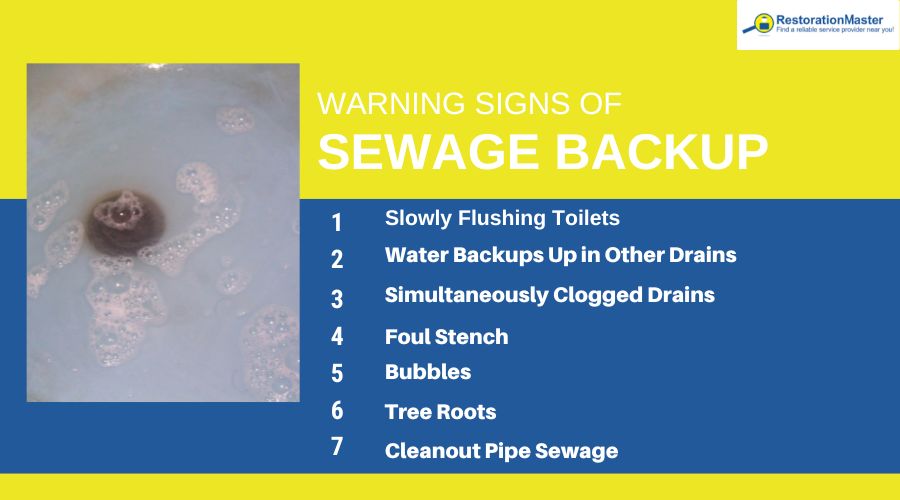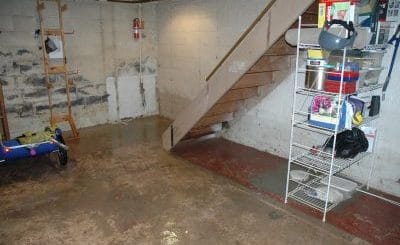What are the Warning Signs of a Sewage Backup?
The main sewer line is connected to the entire plumbing system inside a home. The sewer line can take a hit and clog, as a result of the numerous drains, pipes, and other plumbing fixtures leading into the sewer line. But a blocked sewageSewage is wastewater containing biological and chemical cont... More backup is a hazardous mess to repairRepair is the act of fixing or restoring damaged property, m... More.
When the washing machine, dishwasher, toilets, and bathtubs drain properly, there is really no need to even look at the main sewer line. Consequently, homeowners are unlikely to pay much attention to the sewer line, at first. But several warning signs can erupt and point to a sewage backup.
One clogged drain is different from a blocked sewer drain. Usually, when the sewer drain is blocked, all the plumbing fixtures in the home will back up at the same time. When any of the following warning signs occur, the clogged sewer drain will require a repairRepair is the act of fixing or restoring damaged property, m... More or a replacement.

warning signs for sewageSewage is wastewater containing biological and chemical cont... More backup
Warning Sign #1: Slowly Flushing Toilets
When the toilet bowl no longer swirls water down the drain, it is a potential sewer drain problem. A homeowner might plunge the toilet to clear out any clogs within the pipes. If normal plunging fails to improve the water flow, the main sewer line might be to blame.
Warning Sign #2: Water Backups Up in Other Drains
Flushing the toilet should not cause the bathtub drain to gurgle water. When gurgling sounds persist, it is an indication that the flow of water from the toilet is blocked and looking for an exit route. Water that cannot pass through will start to back up.
Along the same lines, the washing machine may cause the water in the toilet bowl to bubble. Similar warnings of sewageSewage is wastewater containing biological and chemical cont... More backups include when the homeowner runs the water in the sink and the water in the toilet unexpectedly starts to rise or bubble.
Warning Sign #3: Simultaneously Clogged Drains
One clogged drain is bad enough. Trapped hair in the bathtub drain can leadLead is a heavy metal that can be toxic to humans, especiall... More to slowly moving water. Grease poured down the kitchen sink can solidify and clog the drain. Unclogging the blocked drains will typically allow normal water flow. But simultaneous clogs are a bigger problem.
Blocked drains in multiple parts of the home will not let wastewaterWastewater is used water that contains contaminants, chemica... More pass through. A sewageSewage is wastewater containing biological and chemical cont... More backup is the culprit. Oftentimes, the lowest drains of the home will be affected first. The problem becomes even worse when rarely used drains, like those in the guest bathrooms, start to back up.
Warning Sign #4: Foul Stench
Household drains do not produce noxious smells. But when a homeowner suddenly starts to whiff foul odors coming from the drains, it could be a sign of a main sewer line problem. Properly working drains leadLead is a heavy metal that can be toxic to humans, especiall... More wastewaterWastewater is used water that contains contaminants, chemica... More out of the home, so a foul stench should not be present indoors.
Warning Sign #5: Bubbles
Air can become trapped and cause bubbles, especially in instances when the wastewaterWastewater is used water that contains contaminants, chemica... More attempts to bypass a clog in the drain. When the water cannot get past the blockage, it will back up. Bubbling drains are easy to spot and are almost always a red flag for sewageSewage is wastewater containing biological and chemical cont... More backups.
Homeowners who notice bubbles should determine whether it is a one-time occurrence or a sign of a major drainage problem. A simple check may be conducted by filling up the sink and bathtub with two inches of water. If the drain bubbles, it is likely a sewer drain problem.
Warning Sign #6: Tree Roots
Older homes may feature poorly connected sewer lines that were constructed out of clay or other porousPorous describes a material that contains small openings or ... More materials. When these homes are surrounded by trees, the tree roots naturally search for water. If the roots grow into the sewer pipes, the roots expand and rupture the pipe.
Early signs that tree roots have invaded the sewer pipes include drains that flow unusually slow, as well as gurgling toilets. If the homeowner ignores the drainage problems caused by the tree roots, the issue will worsen as the tree roots grow larger over time.
Warning Sign #7: Cleanout Pipe Sewage
The sewer line can be directly accessed through a capped cleanout pipe, which is located in the basement or outside. A backup in the sewer line can push wastewaterWastewater is used water that contains contaminants, chemica... More back up and through the cleanout pipe. SewageSewage is wastewater containing biological and chemical cont... More exiting in the yard or basement is indicative of a sewageSewage is wastewater containing biological and chemical cont... More backup.
WastewaterWastewater is used water that contains contaminants, chemica... More will usually accumulate in the cleanout pipe as the backup builds. At some point it will spill out. Homeowners are advised to examine the cleanout pipe when additional signs of a sewageSewage is wastewater containing biological and chemical cont... More backup are present. Standing water in the cleanout pipe points to a sewageSewage is wastewater containing biological and chemical cont... More backup problem.
When warning signs of a sewageSewage is wastewater containing biological and chemical cont... More backup are apparent, homeowners should take swift action. Certain drain cleaning and maintenanceMaintenance is the routine care, inspection, and repair of a... More tasks can be DIY projects, while replacing sections of the sewer line or replacing the entire system should be handled by professionals.
Contact Sewage Cleaning Professionals

sewageSewage is wastewater containing biological and chemical cont... More cleanup services restorationmaster
Same-day fixes by licensed plumbers should be scheduled, along with services provided by experienced sewage cleanup experts. SewageSewage is wastewater containing biological and chemical cont... More leaking into the home is a dangerous situation and should be remedied by professionals as soon as possible.
SewageSewage is wastewater containing biological and chemical cont... More water is contaminated with bacteria, harmful toxins, and biohazards. Homeowners should avoid coming into direct contact with sewageSewage is wastewater containing biological and chemical cont... More water. Instead, consult disaster restorationRestoration is the process of returning a property to its pr... More professionals for immediate cleanup. Permanent structural damage can also occur as contaminated sewageSewage is wastewater containing biological and chemical cont... More water is absorbed into porousPorous describes a material that contains small openings or ... More materials.
Our professional technicians are equipped with advanced tools and cleaning products to safely return your home to a habitable condition. Upon removing the toxic sewageSewage is wastewater containing biological and chemical cont... More, we will thoroughly dry the premises and disinfect the area so that your home may be safely occupied again.












